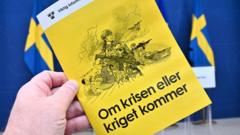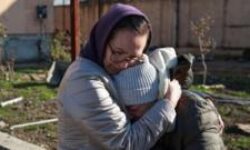
Nordic Countries Prepare Citizens for Potential Crises and Conflicts
Several Nordic countries are taking proactive steps to prepare their populations for potential emergencies, including war and extreme weather events, by distributing comprehensive preparedness guides.
Sweden is leading this effort by sending out an updated version of its “If crisis or war comes” pamphlet to millions of households starting Monday. The booklet, which is twice the size of its previous edition from six years ago, has been revised due to the worsening security situation, particularly following Russia’s invasion of Ukraine.
Neighboring countries are also taking similar approaches. Finland has published a digital preparedness guide, while Norway has distributed 2.2 million paper copies to households. Denmark has been emailing adults information about crisis preparedness.
These guides provide detailed instructions on surviving various scenarios, with a particular focus on self-sufficiency during the initial stages of a crisis. They recommend stockpiling essential supplies like:
– Long-life foods (canned beans, pasta, energy bars)
– Medicines, including iodine tablets
– Emergency food supplies
– Backup power sources
The pamphlets reflect the changing geopolitical landscape in the region. Both Sweden and Finland, traditionally neutral countries, have recently joined or applied to join NATO in response to increased regional tensions. Norway has long been a NATO member.
Sweden’s Civil Defence Minister Carl-Oskar Bohlin emphasized the importance of updating citizens’ information to reflect global changes. He has previously warned about the potential for conflict, urging citizens to take preparedness seriously.
Finland, with its long border with Russia and historical experience, has maintained a consistently high level of defense preparedness. In contrast, Sweden had scaled down its infrastructure but is now rebuilding its “total defence” capabilities.
The guides address various potential scenarios, including:
– Surviving without power during extreme winter conditions
– Managing during potential military conflicts
– Coping with extreme weather events
Each country’s approach varies slightly. Finland asks citizens how they would survive without power in temperatures as low as -20C, while Sweden’s checklist includes specific food recommendations like potatoes, cabbage, and canned sauces.
Experts like Ilmari Kaihko from the Swedish Defence University note the cultural differences in preparedness between countries. He observes that Finland never forgot the possibility of war, whereas Sweden needed more prompting to take such scenarios seriously.
Public reactions are mixed. Some citizens, like Swedish economist Ingemar Gustafsson, remain calm but appreciate the information. Others, like Melissa Eve Ajosmaki, a Finnish student in Sweden, maintain a background awareness of potential risks.
One common recommendation across these guides is to maintain a 72-hour emergency supply of food and water, though practical challenges exist, such as storage limitations in small apartments.
These preparedness efforts represent a comprehensive approach to national resilience, emphasizing citizen readiness and self-sufficiency during potential crises.








